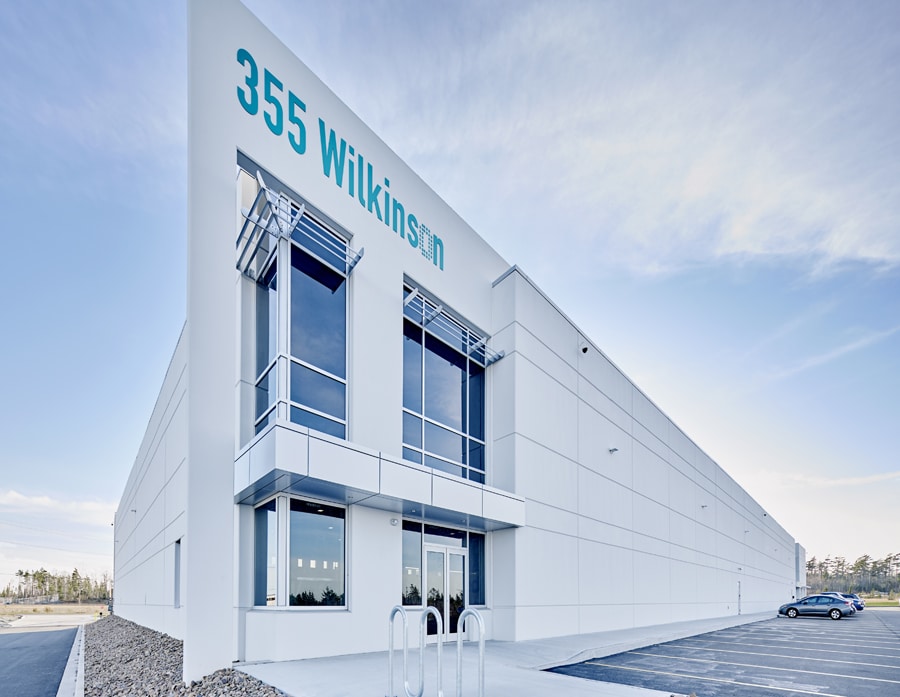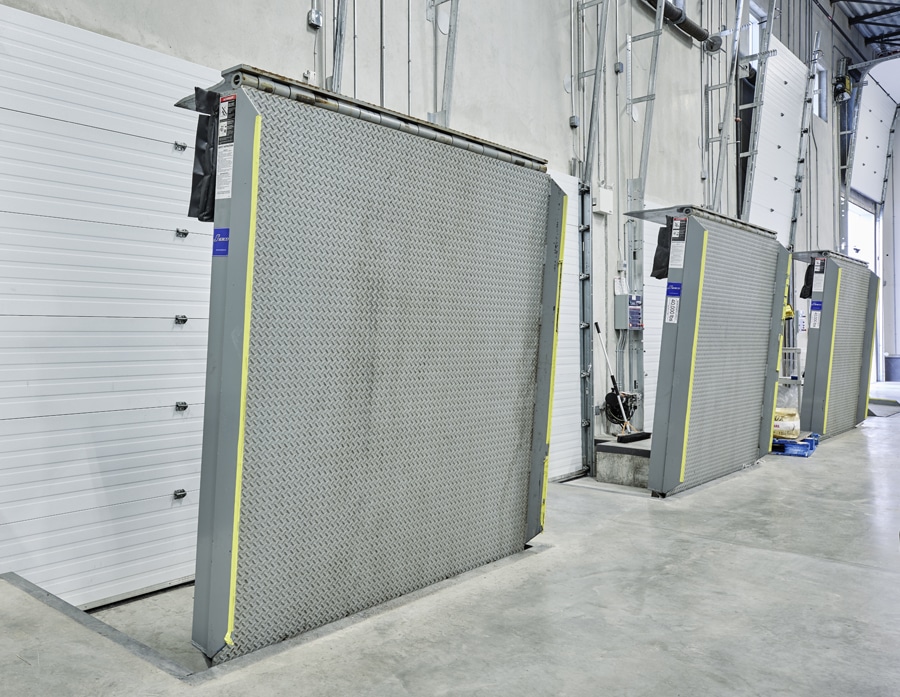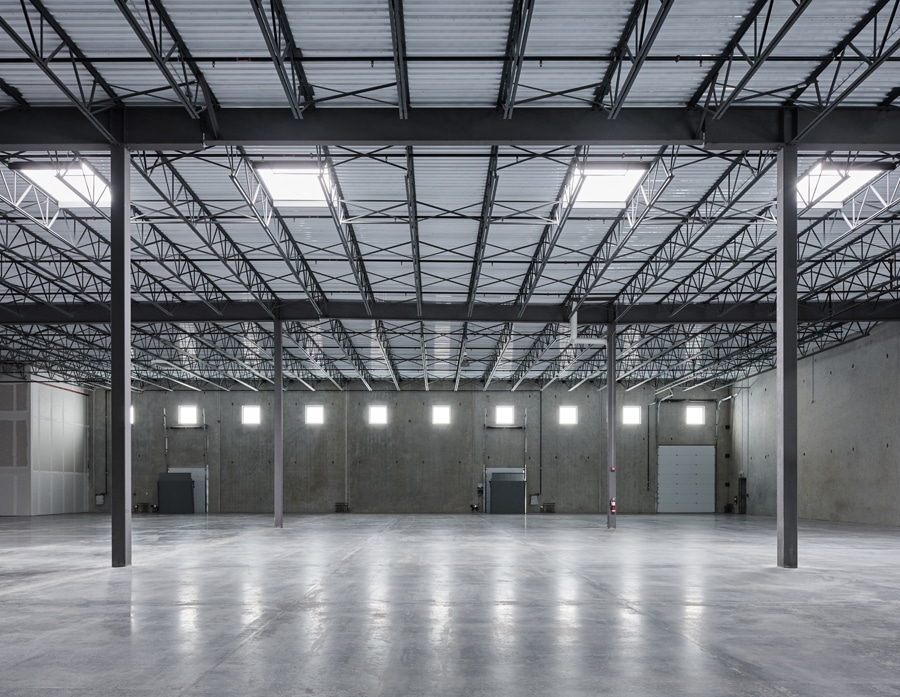Wilkinson Ave Net-Zero Heating Warehouse
Dartmouth, Nova Scotia
August 7, 2020
- Rating System/Standard
- Zero Carbon Building
- Building Type
- Industrial
Building a New Generation of Zero Carbon Warehouses
Located in Dartmouth, Nova Scotia, the Wilkinson Warehouses are multi-tenant warehouse buildings. Developer and property manager East Port Properties intended the facilities to be built to a next-generation standard. To achieve this, they joined Canada Green Building Council (CaGBC) Zero Carbon Building (ZCB) pilot project to combine their knowledge of efficient warehouse design with CaGBC’s new certification.
Within the Wilkinson project, the larger development will include a series of four or five multi-tenant warehouses totaling approximately 300,000 square feet. The first phase of the project was a 65,000-square-foot building. For this build, East Port—working in partnership with Efficiency Nova Scotia—focused on designing a building that would keep tenants’ operating costs as low as possible. Their efforts paid off, with the Wilkinson project receiving its Zero Carbon-Design certification.
Project Team
- Developer
- East Port Properties
- Prime Consultant Engineer
- Ruitenberg Inc
- Sustainability Consultant
- East Port Properties
- Mechanical Engineer
- Barber Engineering Services
- Structural Engineer
- Laurence Smith
- Electrical Engineer
- MCW
- Landscape Architect
- DesignPoint Engineering & Surveying
- Builder
- Lindsay Construction
- CaGBC members involved with this project
- East Port Properties, MCW, and VELUX
Reimagining Industrial Class Assets
East Port Properties prides itself on developing and managing high-performance buildings, including Leadership in Energy and Environmental Design® (LEED) certified buildings. They are known for developing, building, and operating the first LEED-certified multi-tenant warehouse in Halifax, Nova Scotia, as well as the first LEED Gold Certified office building in St. John’s, Newfoundland. With the pilot program, East Port felt they could advocate for multi-tenant industrial real estate, an asset class that isn’t typically top of mind during the development of building standards—despite representing over two billion square feet of real estate in 11 Canadian markets. With East Port’s experience in the industrial space, they felt it was possible to create a comfortable, leasable building and to provide tenants with a $0 central heating bill.
Getting to Zero Carbon
Making $0 central heating a reality required 355 Wilkinson’s design feature a tight and well-insulated building envelope. Based on experience with previous LEED-certified warehouses, the East Port team knew the key elements that would have significant impact on building energy use: reduced infiltration, better insulation values, efficient heating systems, and automated controls to reduce dependence on human intervention to operate the system.
East Port started with insulated tilt-up concrete sandwich panels to provide continuous R-20 insulation value in the warehouse, and a durable concrete surface suitable for industrial use. Further infiltration reduction was achieved by using vertical-storing dock levelers, a product typically used in cold storage warehouses to keep the cold in. They also upgraded the insulation value of the roof to R-40.
The building is heated with central in-floor heat supplied via air-to-water heat pumps. The central heating system consists of six air-to-water heat pumps and a peak-load/back-up condensing natural gas boiler that provides a constant floor temperature of 17°C. The hot water distribution is provided by electronically commutated motor (ECM) circulator pumps in single-bay zones.
Additional heating is supplied by overhead unit heaters that are metered and billed directly to the tenant. Controls were put in place to stop in-floor heating circulators from running in areas with open overhead doors. With the tenant-metered overhead unit heaters making up for open doors, tenants become more aware of the cost implications of how they operate their premises.
East Port also installed a net-metered solar photovoltaic (PV) system through Nova Scotia Power’s Net Metering program. The system is sized to offset the cost of fuel sources—assuming a heating energy intensity of 1.6 e-kWh per square foot. With these heating considerations, a tenant could see a $0 central heating bill with less frequent door openings.

Building to Zero Carbon Advantage
East Port had built LEED-certified projects before but was especially excited about participating in the Zero Carbon Building Pilot Program. Beyond their desire to push their assets further and better differentiate themselves in the market, the pilot also provided East Port an opportunity to share their expertise and potentially impact further standard development.
Working with the ZCB standard meant changing East Port’s approach. Rather than starting with a list of requirements, they worked backward from the end-point required to achieve their goal. The team faced a few challenges, among them the need for a third-party energy model to validate the design—an energy model that did not reflect the empirical data collected about infiltration rates in existing, operating LEED Certified warehouses in their portfolio—and dealing with restrictions by the local utility around how much on-site energy they could provide to the grid.
Realizing True ROI
Despite these challenges, the most ambitious aspect of the project was understanding how to make the project financially competitive. Traditionally, the focus for this asset class was on providing the lowest-cost product, especially since developers don’t always know what the building’s final use will be, or how that usage might change over time.
The team found working with the ZCB standard simple and easy to navigate, as well as cost-effective. While East Port did see approximately a 10-15 per cent premium for building to Zero Carbon over standard, they already see a return on that investment: higher net rents are achieved because tenants have a significantly lower heating energy bill and more comfortable workspace at the same time.
To make the space even more desirable for tenants, East Port included non-standard warehouse features. The buildings are equipped with Solera® windows and skylights to maximize the use of daylighting, LED lights with motion sensors, and automated, energy-efficient ventilation systems.
Increasingly, East Port sees demand for sustainable real estate, and with Wilkinson, they are meeting that demand with smart spaces and value-add property management services. With six months of data at their disposal, the team is on track to achieve its $0 central heating bill goal.
In working to achieve their Zero Carbon certification, East Port focused on what they could control to help their tenants achieve net-zero central heating. By streamlining their approach, they stayed focused and were able to bring innovative thinking to an industrial space—creating the next generation of warehousing for their tenants today.
East Port Properties prides itself on having developed and managed several high-performance Buildings. Having third party certification provides validation of our design and operations as well as recognition of good practices.
— Judy Wall, President, East Port Properties






